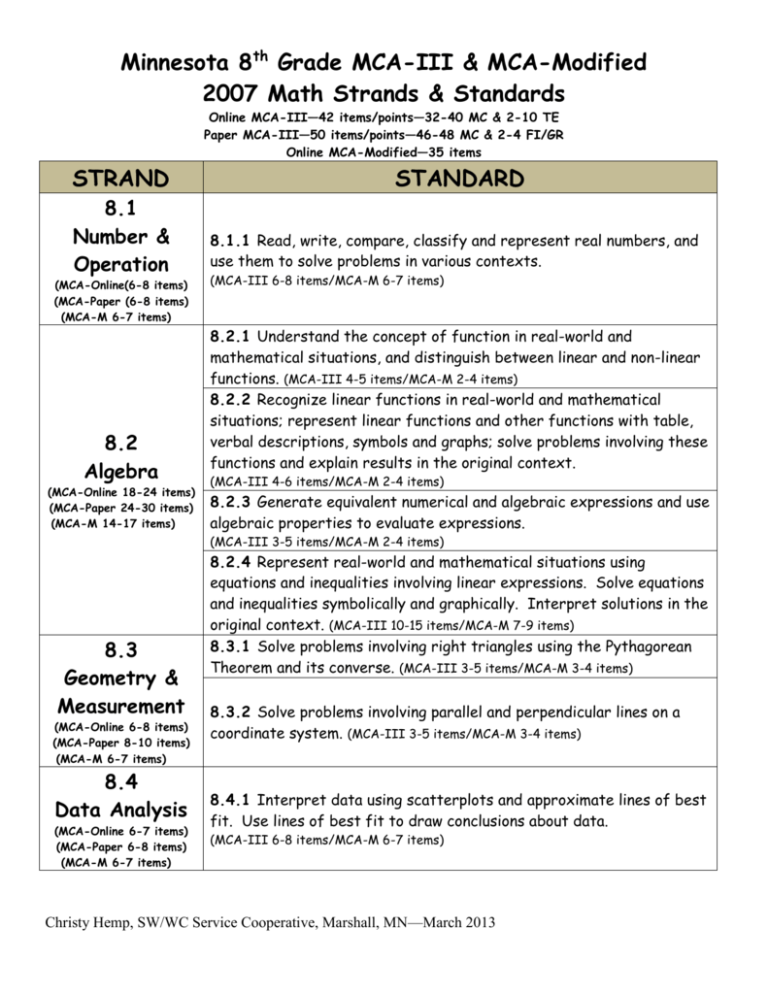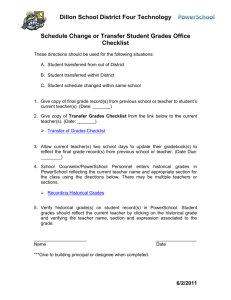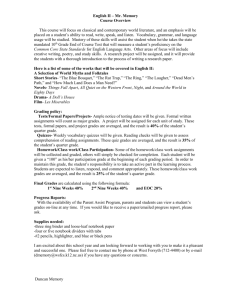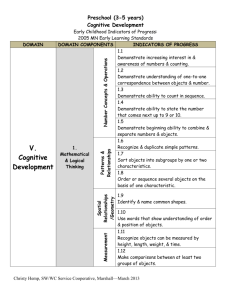8th Grade Math 2007 with MCA-III & MCA-Mod Information
advertisement

Minnesota 8th Grade MCA-III & MCA-Modified 2007 Math Strands & Standards Online MCA-III—42 items/points—32-40 MC & 2-10 TE Paper MCA-III—50 items/points—46-48 MC & 2-4 FI/GR Online MCA-Modified—35 items STRAND 8.1 Number & Operation (MCA-Online(6-8 items) (MCA-Paper (6-8 items) (MCA-M 6-7 items) 8.2 Algebra (MCA-Online 18-24 items) (MCA-Paper 24-30 items) (MCA-M 14-17 items) STANDARD 8.1.1 Read, write, compare, classify and represent real numbers, and use them to solve problems in various contexts. (MCA-III 6-8 items/MCA-M 6-7 items) 8.2.1 Understand the concept of function in real-world and mathematical situations, and distinguish between linear and non-linear functions. (MCA-III 4-5 items/MCA-M 2-4 items) 8.2.2 Recognize linear functions in real-world and mathematical situations; represent linear functions and other functions with table, verbal descriptions, symbols and graphs; solve problems involving these functions and explain results in the original context. (MCA-III 4-6 items/MCA-M 2-4 items) 8.2.3 Generate equivalent numerical and algebraic expressions and use algebraic properties to evaluate expressions. (MCA-III 3-5 items/MCA-M 2-4 items) 8.3 Geometry & Measurement (MCA-Online 6-8 items) (MCA-Paper 8-10 items) (MCA-M 6-7 items) 8.4 Data Analysis (MCA-Online 6-7 items) (MCA-Paper 6-8 items) (MCA-M 6-7 items) 8.2.4 Represent real-world and mathematical situations using equations and inequalities involving linear expressions. Solve equations and inequalities symbolically and graphically. Interpret solutions in the original context. (MCA-III 10-15 items/MCA-M 7-9 items) 8.3.1 Solve problems involving right triangles using the Pythagorean Theorem and its converse. (MCA-III 3-5 items/MCA-M 3-4 items) 8.3.2 Solve problems involving parallel and perpendicular lines on a coordinate system. (MCA-III 3-5 items/MCA-M 3-4 items) 8.4.1 Interpret data using scatterplots and approximate lines of best fit. Use lines of best fit to draw conclusions about data. (MCA-III 6-8 items/MCA-M 6-7 items) Christy Hemp, SW/WC Service Cooperative, Marshall, MN—March 2013 Christy Hemp, SW/WC Service Cooperative, Marshall, MN—March 2013 8th Grade—Number & Operation Strand 2007 MN Math Standard to Benchmarks with Vocabulary & Symbols from MCA-III & MCA-Modified Draft Test Specifications (MCA-Online 6-8 items) MCA-Paper 6-8 items) (MCA-M 6-7 items) STANDARD 8.1.1 Read, write, compare, classify & represent real numbers, & use them to solve problems in various contexts. (MCA-Online 6-8 items) (MCA-Paper 6-8 items) (MCA-M 6-7 items) VOCABULARY irrational real square root radical vocabulary given at previous grades BENCHMARK 8.1.1.1 Classify real numbers as rational or irrational. Know that when a square root of a positive integer is not an integer, then it is irrational. Know that the sum of a rational number & an irrational number is irrational, & the product of a non-zero rational number & and irrational number is irrational. For example: Classify the following numbers as whole numbers, integers, rational numbers, irrational numbers, recognizing that some numbers may be in more than one category: 2 square root radical consecutive vocabulary given at previous grades , square root radical consecutive vocabulary , 3 6 , 3.6 , 4 , 10 , -6.7. Allowable notation: 18 8.1.1.2 Compare real numbers; locate real numbers on a number line. Identify the square root of a positive integer as an integer, or if it is not an integer, locate it as a real number between two consecutive positive integers. For example: Put the following numbers in order from smallest to largest: 2, Another example: 6 3 3 , -4, -6.8, 37 . 68 is an irrational number between 8 & 9. Allowable notation: 18 8.1.1.3 Determine rational approximations for solutions to problems involving real numbers. Christy Hemp, SW/WC Service Cooperative, Marshall, MN—March 2013 given at previous grades For example: A calculator can be used to determine that is approximately 2.65. Another example: To check that 7 1 125 is slightly bigger than 2 , do the calculation 2 289 1 (1 125 ) 2 ( 17 12 ) 144 2 144 . Another example: Knowing that 10 is between 3 & 4, try squaring numbers like 3.5, 3.3, 3.1 to determine that 3.1 is a reasonable rational approximation of vocabulary given at previous grades scientific notation significant digits standard form vocabulary given at previous grades 10 . Allowable notation: 18 8.1.1.4 Know & apply the properties of positive & negative integer exponents to generate equivalent numerical expressions. ( 5) For example: 3 3 2 3( 3) ( 13 )3 1 27 . Allowable notation: -x², (-x)², -3², (-3)² Expressions may be numeric or algebraic 8.1.1.5 Express approximations of very large & very small numbers using scientific notation; understand how calculators display numbers in scientific notation. Multiply & divide numbers expressed in scientific notation, express the answer in scientific notation, using the correct number of significant digits when physical measurements are involved. For example: (4.2 104 ) (8.25 103 ) 3.465 108 , but if these numbers represent physical measurements, the answer should be expressed as 3.5 10 because the first factor, 8 4.2 104 , only has two significant digits. Christy Hemp, SW/WC Service Cooperative, Marshall, MN—March 2013 8th Grade—Algebra Strand 2007 MN Math Standard to Benchmarks with Vocabulary & Symbols from MCA-III & MCA-Modified Draft Test Specifications (MCA-III 24-30 items) (MCA-M 14-17 items) STANDARD 8.2.1 Understand the concept of function in real-world & mathematical situations, & distinguish between linear & nonlinear functions. (MCA-Online 4-5 items) (MCA-Paper 4-5 items) (MCA-M 2-4 items) VOCABULARY independent dependent constant coefficient vocabulary given at previous grades BENCHMARK 8.2.1.1 Understand that a function is a relationship between an independent variable & a dependent variable in which the value of the independent variable determines the value of the dependent variable. Use functional notation, such as f(x), to represent such relationships. For example: The relationship between the area of a square & the side length can be expressed as f ( x) x 2 . In this case, f (5) 25, which represents the fact that a square of side length 5 units has area 25 units squared. independent dependent constant coefficient vocabulary given at previous grades linear constant coefficient vocabulary given at previous grades 8.2.1.2 Use linear functions to represent relationships in which changing the input variable by some amount leads to a change in the output variable that is a constant times that amount. For example: Uncle Jim gave Emily $50 on the day she was born & $25 on each birthday after that. The function f ( x) 50 25 x represents the amount of money Jim has given after x years. The rate of change is $25 per year. 8.2.1.3 Understand that a function is linear if it can be expressed in the form f ( x) mx b or if its graph is a straight line. 2 For example: The function f ( x) x is not a linear function because its graph contains the points (1, 1), (1, 1) & (0, 0), which are not on a straight line. Christy Hemp, SW/WC Service Cooperative, Marshall, MN—March 2013 8.2.2 Recognize linear functions in real-world & mathematical situations; represent linear functions & other n th term arithmetic sequence geometric sequence linear function non-linear function progression common difference vocabulary given at previous grades n th term arithmetic sequence geometric sequence linear function non-linear function exponential progression common ratio vocabulary given at previous grades 8.2.1.4 Understand that an arithmetic sequence is a linear function that can be expressed in the form f ( x) mx b , where x = 0, 1, 2, 3,…. For example: The arithmetic sequence 3, 7, 11, 15, … can be expressed as f ( x) 4 x 3. 8.2.1.5 Understand that a geometric sequence is a non-linear function that can be expressed in the form f ( x) ab x , where x = 0, 1, 2, 3, …. For example: The geometric sequence 6, 12, 24, 48, … can be expressed in the form f ( x) 6(2 x ) . linear function vocabulary given at previous grades 8.2.2.1 Represent linear functions with tables, verbal descriptions, symbols, equations & graphs; translate from one representation to another. linear function intercept vocabulary given at previous grades 8.2.2.2 Identify graphical properties of linear functions including slopes & intercepts. Know that the slope equals the rate of change, & that the y-intercept is zero when the function represents a proportional relationship. Christy Hemp, SW/WC Service Cooperative, Marshall, MN—March 2013 functions with tables, verbal descriptions, symbols & graphs; solve problems involving these functions & explain results in the original context. (MCA-Online 4-6 items) (MCA-Paper 4-6 items) (MCA-M 2-4 items) linear function intercept coefficient constant vocabulary given at previous grades n th term arithmetic sequence geometric sequence linear function non-linear function progression vocabulary given at previous grades n th term arithmetic sequence geometric sequence linear function non-linear function progression vocabulary given at previous grades Coordinates used for determining slope must contain integer values 8.2.2.3 Identify how coefficient changes in the equation f ( x) mx b affect the graphs of linear functions. Know how to use graphing technology to examine these effects. 8.2.2.4 Represent arithmetic sequences using equations, tables, graphs & verbal descriptions, & use them to solve problems. For example: If a girl starts with $100 in savings & adds $10 at the end of each month, she will have 100 + 10x dollars after x months. 8.2.2.5 Represent geometric sequences using equations, tables, graphs & verbal descriptions, & use them to solve problems. For example: If a girl invests $100 at 10% annual interest, she will have Christy Hemp, SW/WC Service Cooperative, Marshall, MN—March 2013 100(1.1x ) dollars after x years. 8.2.3 Generate equivalent numerical & algebraic expressions & use algebraic properties to evaluate expressions. (MCA-Online 2-4 items) (MCA-Paper 3-5 items) (MCA-M 2-4 items) 8.2.4 Represent realworld & mathematical situations using equations & inequalities involving linear expressions. Solve equations & inequalities symbolically & graphically. Interpret vocabulary given at previous grades 8.2.3.1 Evaluate algebraic expressions, including expressions containing radicals & absolute values, at specified values of their variables. For example: Evaluate r h when r = 3 & h = 0.5, & then use an approximation of to obtain an approximate answer. 2 Items must not have context Directives may include: simplify, evaluate 8.2.3.2 Justify steps in generating equivalent expressions by identifying the properties used, including the properties of algebra. Properties include the associative, commutative & distributive laws, & the order of operations, including grouping symbols. associative commutative distributive property order of operations identity vocabulary given at previous grades vocabulary given at previous grades Items must not have context 8.2.4.1 Use linear equations to represent situations involving a constant rate of change, including proportional & non-proportional relationships. For example: For a cylinder with fixed radius of length 5, the surface area A 2 5 h 2 5 10 h 50 , is a linear 2 function of the height h, but the surface area is not proportional to the height. vocabulary given at previous grades 8.2.4.2 Solve multi-step equations in one variable. Solve for one variable in a multi-variable equation in terms of the other variables. Justify the steps by identifying the properties of equalities used. For example: The equation 10x + 17 = 3x can be changed to 7x + 17 = 0, & then to 7x = -17 by Christy Hemp, SW/WC Service Cooperative, Marshall, MN—March 2013 solutions in the original context. adding/subtracting the same quantities to both sides. These changes do not change the solution of the equation. Another example: Using the formula for the perimeter of a rectangle, solve for the base in terms of the height & perimeter. (MCA-Online 8-14 items) (MCA-Paper 10-15 items) (MCA-M 7-9 items) slope-intercept form point-slope form standard form vocabulary given at previous grades 8.2.4.3 Express linear equations in slope-intercept, point-slope & standard forms, & convert between these forms. Given sufficient information, find an equation of a line. For example: Determine an equation of the line through the points (-1, 6) & (2/3, -3/4). Items must not have context 8.2.4.4 Use linear inequalities to represent relationships in various contexts. vocabulary given at previous grades For example: A gas stations charges $0.10 less per gallon of gasoline if a customer also gets a car wash. Without the car wash, gas costs $2.79 per gallon. The car wash it $8.95. What are the possible amounts (in gallons) of gasoline that you can buy if you also get a car wash & can spend at most $35? Inequalities contain no more than 1 variable 8.2.4.5 Solve linear inequalities using properties of inequalities. Graph the solutions on a number line. vocabulary given at previous grades vocabulary given at previous grades For example: The inequality -3x < 6 is equivalent to x > -2, which can be represented on the number line by shading in the interval to the right of -2. 8.2.4.6 Represent relationships in various contexts with equations & inequalities involving the absolute value of a linear expression. Solve such equations & inequalities & graph the solutions on a number line. Christy Hemp, SW/WC Service Cooperative, Marshall, MN—March 2013 For example: A cylindrical machine part is manufactured with a radius of 2.1 cm, with a tolerance of 1/100cm. The radius r satisfies the inequality r 2.1 0.01. system of equations undefined infinite intersecting identical vocabulary given at previous grades 8.2.4.7 Represent relationships in various contexts using systems of linear equations. Solve systems of linear equations in two variables symbolically, graphically & numerically. For example: Marty’s cell phone company charges $15 per month plus $0.04 per minute for each call. Jeannine’s company charges $0.25 per minute. Use a system of equations to determine the advantages of each plan based on the number of minutes used. 8.2.4.8 Understand that a system of linear equations may have no solution, one solution, or an infinite number of solutions. Relate the number of solutions to pairs of lines that are intersecting, parallel or identical. Check whether a pair of numbers satisfies a system of two linear equations in two unknowns by substituting the numbers into both equations. Assessed within 8.2.4.7 8.2.4.9 Use the relationship between square roots & squares of a number to solve problems. For example: If square root vocabulary given at previous grades equivalently, x x2 5, 5 then x or x 5 5 , or . If x is understood as the radius of a circle in this example, then the negative solution should be discarded & x 5 . Allowable notation: ±3 Items may assess the interpretation of square roots based on the context of the item 8th Grade—Geometry & Measurement Strand Christy Hemp, SW/WC Service Cooperative, Marshall, MN—March 2013 2007 MN Math Standard to Benchmarks with Vocabulary & Symbols from MCA-III & MCA-Modified Draft Test Specifications (MCA-Online 6-8 items) MCA-Paper 8-10 items) (MCA-M 6-7 items) STANDARD VOCABULARY 8.3.1 Solve problems involving right triangles using the Pythagorean Theorem and its converse. Pythagorean Theorem vocabulary given at previous grades 8.3.1.1 Use the Pythagorean Theorem to solve problems involving right triangles. For example: Determine the perimeter of a right triangle, given the lengths of two of its sides. Another example: Show that a triangle with side lengths 4, 5 and 6 is not a right triangle. Congruent angle marks may be used 8.3.1.2 Determine the distance between two points on a horizontal or vertical line in a coordinate system. Use the Pythagorean Theorem to find the distance between any two points in a coordinate system. Pythagorean Theorem vocabulary given at previous grades (MCA-Online 3-4 items) (MCA-Paper 3-5 items) (MCA-M 3-4 items) 8.3.2 Solve problems involving parallel and perpendicular lines on a coordinate BENCHMARK vocabulary given at previous grades vocabulary Graphs are not provided when finding horizontal or vertical distance 8.3.1.3 Informally justify the Pythagorean Theorem by using measurements, diagrams and computer software. Not assessed on the MCA-III 8.3.2.1 Understand and apply the relationships between the slopes of parallel lines and between the slopes of perpendicular lines. Dynamic graphing software may be used to examine these relationships. Equations within an item must be given in the same form 8.3.2.2 Christy Hemp, SW/WC Service Cooperative, Marshall, MN—March 2013 system. given at previous grades (MCA-Online 3-4 items) (MCA-Paper 3-5 items) (MCA-M 3-4 items) vocabulary given at previous grades Analyze polygons on a coordinate system by determining the slopes of their sides. For example: Given the coordinates of four points, determine whether the corresponding quadrilateral is a parallelogram. 8.3.2.3 Given a line on a coordinate system and the coordinates of a point not on the line, find lines through that point that are parallel and perpendicular to the given line, symbolically and graphically. 8th Grade—Data Analysis & Probability Strand Christy Hemp, SW/WC Service Cooperative, Marshall, MN—March 2013 2007 MN Math Standard to Benchmarks with Vocabulary & Symbols from MCA-III & MCA-Modified Draft Test Specifications (MCA-Online 6-7 items) (MCA-Paper 6-8 items) (MCA-M 6-7 items) STANDARD 8.4.1 Interpret data using scatterplots and approximate lines of best fit. Use lines of best fit to draw conclusions about data. (MCA-Online 6-7 items) (MCA-Paper 6-8 items) (MCA-M 6-7 items) VOCABULARY scatterplot line of best fit correlation vocabulary given at previous grades BENCHMARK 8.4.1.1 Collect, display and interpret data using scatterplots. Use the shape of the scatterplot to informally estimate a line of best fit and determine an equation for the line. Use appropriate titles, labels and units. Know how to use graphing technology to display scatterplots and corresponding lines of best fit. Data sets are limited to no more than 30 data points 8.4.1.2 Use a line of best fit to make statements about approximate rate of change and to make predictions about values not in the original data set. scatterplot line of best fit vocabulary given at previous grades scatterplot line of best fit vocabulary given at previous grades For example: Given a scatterplot relating student heights to shoe sizes, predict the shoe size of a 5'4" student, even if the data does not contain information for a student of that height. 8.4.1.3 Assess the reasonableness of predictions using scatterplots by interpreting them in the original context. For example: A set of data may show that the number of women in the U.S. Senate is growing at a certain rate each election cycle. Is it reasonable to use this trend to predict the year in which the Senate will eventually include 1000 female Senators? Christy Hemp, SW/WC Service Cooperative, Marshall, MN—March 2013





